Utica Leasing Up in Columbiana County, Royalties Down
LISBON, Ohio – Energy companies doing business in Columbiana County have exhibited a strong appetite for new lease deals with property owners across the Utica/Point Pleasant shale formation over the last year, records show.
It amounts to what is a post-COVID rush to expand or renew existing leaseholds across the county and other areas of the shale play, says attorney Alan Wenger, who oversees the oil and gas division of Harrington, Hoppe and Mitchell law firm in Youngstown.
“It’s become evident in the aftermath of COVID,” Wenger says.
Yet gone are the days when these leases commanded lucrative signing bonuses and promising royalty returns, Wenger says. Twelve years ago, major oil and gas companies – led by Chesapeake Energy Corp. – descended on eastern Ohio in a race to lock up acreage positions in what was then the unproven Utica/Point Pleasant. Some agreements at that time yielded bonuses of $6,000 an acre and royalties of 20% gross production of an oil and gas well.
Today, many of those lease agreements that covered acreage where wells were not drilled have expired, and companies have returned to the table to re-sign property owners to new leases. Or, these energy companies have reached out to landowners whose acreage was not leased during the initial push.
“They’re back, and people think the terms should be the same,” Wenger says. “It’s not happening. The days of $5,000 and $6,000 bonuses and 20% royalties don’t happen anymore.”
Wenger says property owners no longer hold the leverage they used to, as the Ohio Department of Natural Resources and changes in state law have made it easier for oil and gas firms to combine property tracts for drilling purposes – a practice commonly known as unitization, or “forced pooling.” In Ohio, a unit consists of 640 contiguous surface acres.
Wenger says that landowners who are designated as part of a well unit, but have refused to lease their land to an oil and gas company, today negotiate from a disadvantage. “In my experience, the ability of landowners to negotiate is compromised since the boom,” he says.
Under Ohio law, a unit today requires that 65% of the landowners within the pool approve of developing a well. “It used to be about 90%. It used to be a roadblock,” Wenger says.
Once an application for a unit is filed with ODNR, then the chief of the oil and gas division will hold a hearing as to whether the unit should be approved. Should the unit go forward, those landowners who had not signed leases would be compelled to do so on terms that Wenger says are unfavorable to them.
“The ones who once held out and would get the lion’s share are now going to lose,” he says.
Those landowners who leased acreage during the early phase of the play have seen their royalties diminish over the years, as many of these wells aren’t producing as much compared to when they were first drilled.
“It’s sort of kicking along at a lower level,” observes Gloria Tritten, who lives in Center Township and has a horizontal well on her property. “The payments have been the same since the beginning of the year.”
Tritten says that royalties were slightly higher last year, but have settled down. Production at the Tritten well during the first quarter of 2023 produced 65.2 million cubic feet of gas; during the second quarter, the well yielded 58.2 million cubic feet, according to ODNR data.
Royalties vary from lease to lease, Tritten says, and depend on the terms of each agreement. Production and commodity pricing is also a factor. During the early months of the well’s commission, royalty payments were relatively high, she says. However, a glut in the oil and gas market toward the end of 2014 led to plummeting prices, which affected royalty payments.
“I’ve always treated it as found money,” Tritten says. “You’d be in trouble if you counted on it.”
Others nearby have seen their royalty payments drop precipitously.
“I’d like to know where the royalty checks are,” says Bob Crosser, who owns a 100-acre farm in Center Township. Approximately 80 of his acres are tied to a well unit.
Crosser says he hasn’t seen a royalty payment in two months from the well’s operator, EAP. “It’s been a steady decline since the well started producing.” The Crosser well, as it’s called, was placed into production between seven and eight years ago.
“We were getting about $1,200 a month,” Crosser says. “Two months ago, it was $120 per month, and then two months of nothing.”
Crosser says the highest royalty payment he’s received was $2,000 for a single month. The well was initially drilled by Chesapeake, but Encino purchased their position in the Utica/Point Pleasant in 2018.
Nevertheless, leasing activity is gaining momentum across the Utica/Point Pleasant, data show.
Records from the Columbiana County Recorder’s office show that the three active energy companies that own producing horizontal wells in Columbiana County – EAP Ohio, Hilcorp Energy Co., and Pin Oak Energy Partners LLC – have recorded at least a combined 407 new leases or lease assignments from Jan. 1 through Sept. 19. That’s a 210% increase from 2022, when the three recorded a total of 131 leases. In 2021, EAP, Hilcorp and Pin Oak together recorded 243 leases, records show.
Meanwhile oil and gas production in the county remains strong, according to ODNR data. During the first half of 2023 – the most recent figures available – horizontal wells in Columbiana County pumped out an impressive 376,059 barrels of oil. Oil production across the county is driven by four wells operated by EAP Ohio, a division of Houston-based Encino Energy Partners, in Hanover Township. These wells collectively yielded 366,222 barrels during the first half of 2022.
“Encino’s second pad is online, and we are currently working on a third pad in Columbiana County,” spokeswoman Jackie Stewart said in a statement. “We continue to be cautiously optimistic about the northern Utica play and look forward to seeing ongoing growth and investment in the region.”
These figures represent a shift among energy companies to target what they believe is an emerging oil window in this part of the Utica/Point Pleasant. Traditionally, oil production in the northern tier has been negligible. For example, during the fourth quarter of 2022, the approximately 120 operating wells in the county produced just 5,084 barrels of oil.
During the second quarter, Columbiana County was ranked the fourth-highest oil-producing county in the state, data show, with 142,669 barrels. That’s still well behind heavy-hitters such as Guernsey County to the southeast, which yielded 2.6 million barrels during the period.
Natural gas production through the first half of 2023 was also strong, as Columbiana County’s horizontal wells produced a combined 28.4 billion cubic feet.
Copyright 2024 The Business Journal, Youngstown, Ohio.


